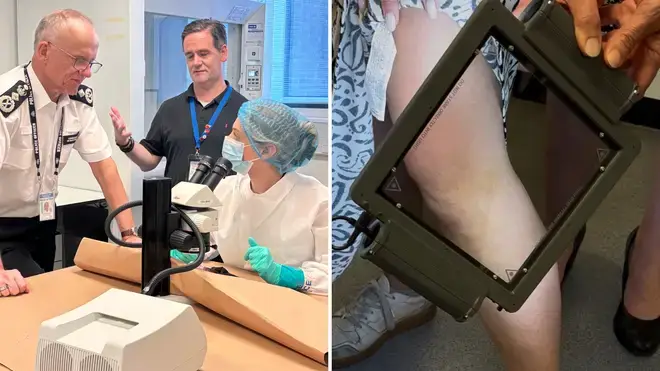The Metropolitan Police is to roll out a new device which makes it easier to record bruising on victims of abuse.
The handheld device, which has been developed by the force, improves colour contrast and makes marks more visible, especially on darker skin.
During a visit to a forensics lab in South London, Commissioner Sir Mark Rowley showed the kit to the Mayor, Sir Sadiq Khan, in which he told him: “If I get bruised it’s much easier to see than if you get bruised, and that’s not fair.”
Speaking to LBC, Sir Mark said: “This is so powerful because a basic requirement through a prosecution if someone has been assaulted is a good image of the bruise and that’s actually easier said than done.
“If it’s a very vivid bruise and it’s very light skin it’s perhaps easier to do but in many situations that isn't the case.
“We’ve had this technology for a while in specialist labs but recognising that it doesn't reach all the victims, our forensic experts have built this handheld device and we’ve been testing tens of them in the hands of officers in some parts of London and it’s really working.
“It’s generating more prosecutions because it helps them get a much more vivid image of a bruise or another injury.
“It’s helping on all victims, on all types of skin, but it’s most useful with people with darker skin colours where the contrast from a bruise, it stands to reason, is less obvious on darker skin sometimes and it’s drawing that image out in a really clear way.
“The thing for us now is to make more of these devices and roll them out much more widely in London."
During a pilot of frontline officers in South London using the device, known as Project Archway, conviction rates for things like strangulation and GBH have gone from as low as 25% to 42%.
Deputy Assistant Commission Ben Russell, who is director of intelligence at the Metropolitan Police, told LBC: “It looks a bit like something you might hold to take a selfie. It’s like a plastic box with a grip on either side and it shines a strong light onto whatever you put underneath it.
“There’s a forensic process called cross-polarisation which is basically about getting the best, strongest image you can and we know that having very clear and effective images of injuries are important particularly when you’re going to a jury and you’re showing them the extent of injuries.
“We think it’s absolutely important to be able to demonstrate the harm these horrible people are conducting on their victims.
“Why it’s so important is that police officers are using regular mobile phones to take evidence and it ultimately might be presented in court so having some simple technology to help make that image even better quality, particularly when it comes to darker skin tone.
“The research shows that violence against women and girls disproportionately affects minority ethnic women so being able to provide an even better service to them is really important for us.”
All police forces in England and Wales have been told to treat tackling violence against women and girls as seriously as they do terrorism – with a bold ambition to halve the number of incidents within a decade.
Minister for safeguarding, Jess Phillips, said she welcomes police “using every lever at their disposal” to achieve that.
But just weeks ago, chiefs – including the Met Commissioner – warned that the goal may be unachievable without more money from the government.
Sir Mark Rowley was unable to say how much the Project Archway devices cost to make but described it as “absolutely worth the investment”.
London Mayor Sir Sadiq Khan also told LBC: “This is innovation from the police service; nowhere else in the country or indeed around the world has this kit and I think it’s going to be game changing.
“Black survivors and victims have been making the point to us that because bruises don’t show up as much on people with darker skin than those with lighter skin that can lead to either charges not being brought or charges that are less serious being brought because the evidence isn’t there.
“What the Met have done is respond to that by inventing a piece of kit that didn’t exist which hopefully shows Londoners, particularly diverse Londoners, that the police are being far more nimble, responsive and proactive to issues that matter.”

